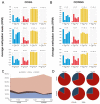Heterosis and Differential DNA Methylation in Soybean Hybrids and Their Parental Lines
- PMID: 35567137
- PMCID: PMC9102035
- DOI: 10.3390/plants11091136
Heterosis and Differential DNA Methylation in Soybean Hybrids and Their Parental Lines
Abstract
Heterosis is an important biological phenomenon and is widely applied to increase agricultural productivity. However, the underlying molecular mechanisms of heterosis are still unclear. Here we constructed three combinations of reciprocal hybrids of soybean, and subsequently used MethylRAD-seq to detect CCGG and CCWGG (W = A or T) methylation in the whole genome of these hybrids and their parents at the middle development period of contemporary seed. We were able to prove that changes in DNA methylation patterns occurred in immature hybrid seeds and the parental variation was to some degree responsible for differential expression between the reciprocal hybrids. Non-additive differential methylation sites (DMSs) were also identified in large numbers in hybrids. Interestingly, most of these DMSs were hyper-methylated and were more concentrated in gene regions than the natural distribution of the methylated sites. Further analysis of the non-additive DMSs located in gene regions exhibited their participation in various biological processes, especially those related to transcriptional regulation and hormonal function. These results revealed DNA methylation reprogramming pattern in the hybrid soybean, which is associated with phenotypic variation and heterosis initiation.
Keywords: DNA methylation; heterosis initiation and formation; reciprocally hybrid seeds; soybean.
Conflict of interest statement
The authors declare no conflict of interest.
Figures




References
Grants and funding
LinkOut - more resources
Full Text Sources

